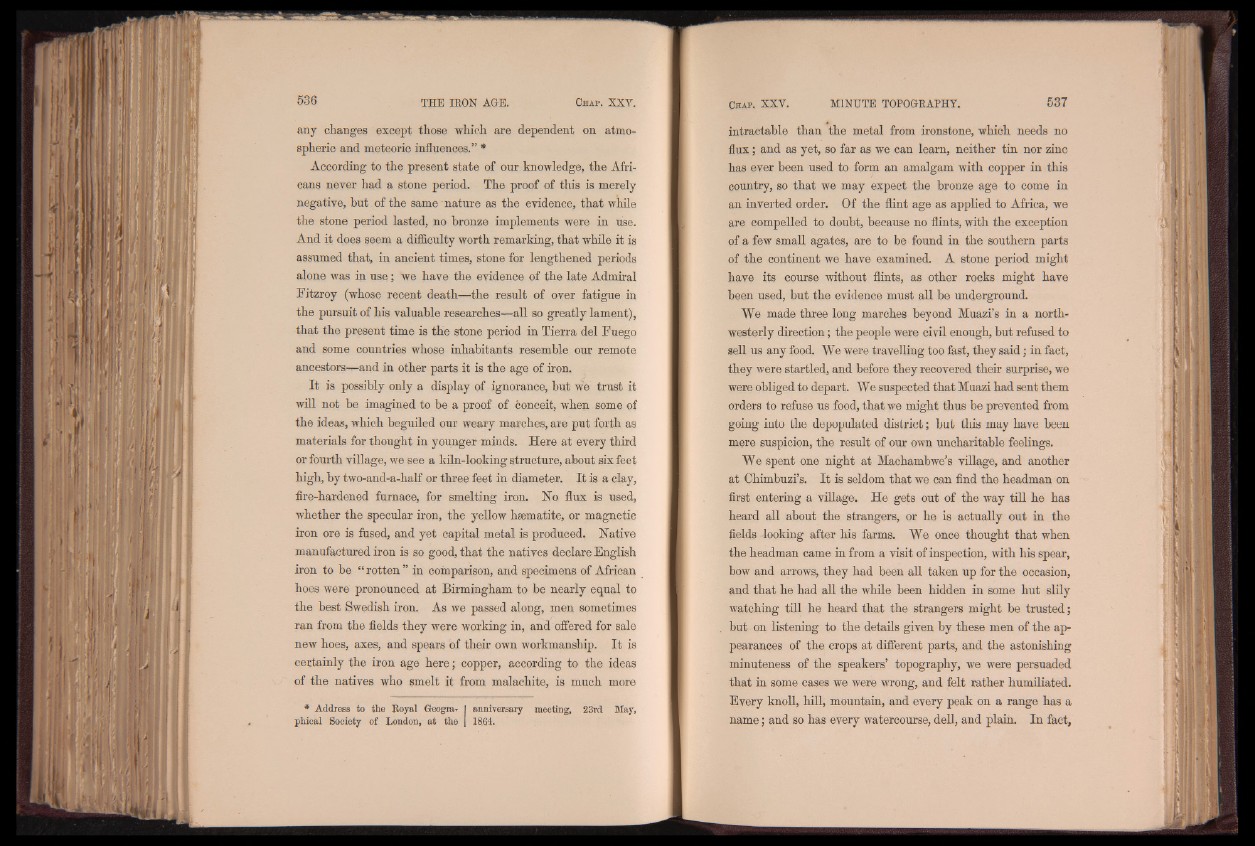
any changes except those which are dependent on atmo-
spherio and meteoric influences.” *
According to the present state of our knowledge, the Africans
never had a stone period. The proof of this is merely
negative, but of the same nature as the evidence, that while
the stone period lasted, no bronze implements were in use.
And it does seem a difficulty worth remarking, that while it is
assumed that, in ancient times, stone for lengthened periods
alone was in use; we have the evidence of the late Admiral
Fitzroy (whose recent death—the result of over fatigue in
the pursuit of his valuable researches—all so greatly lament),
that the present time is the stone period in Tierra del Fuego
and some countries whose inhabitants resemble our remote
ancestors—-and in other parts it is the age of iron.
It is possibly only a display of ignorance, but we trust it
will not be imagined to be a proof of conceit, when some of
the ideas, which beguiled our weary marches, are put forth as
materials for thought in younger minds. Here at every third
or fourth village, we see a kiln-looking structure, about six feet
high, by two-and-a-half or three feet in diameter. It is a clay,
fire-hardened furnace, for smelting iron. No flux is used,
whether the specular iron, the yellow haematite, or magnetic
iron ore is fused, and yet capital metal is produced. Native
manufactured iron is so good, that the natives declare English
iron to be “ rotten” in comparison, and specimens of African
hoes were pronounced at Birmingham to be nearly equal to
the best Swedish iron. As we passed along, men sometimes
ran from the fields they were working in, and offered for sale
new hoes, axes, and spears of their own workmanship. I t is
certainly the iron age here; copper, according to the ideas
of the natives who smelt it from malachite, is much more
* Address to the Royal Geogra. I anniversary meeting, 23rd May,
phical Society of London, at the | 1864.
intractable than the metal from ironstone, which needs no
flux; and as yet, so far as we can learn, neither tin nor zinc
has ever been used to form an amalgam with copper in this
country, so that we may expect the bronze age to come in
an inverted order. Of the flint age as applied to Africa, we
are compelled to doubt, because no flints, with the exception
of a few small agates, are to be found in the southern parts
of the continent we have examined. A stone period might
have its course without flints, as other rocks might have
been used, but the evidence must all be underground.
We made three long marches beyond Muazi’s in a northwesterly
direction; the people were civil enough, but refused to
sell us any food. We were travelling too fast, they said; in fact,
they were startled, and before they recovered their surprise, we
were obliged to depart. We suspected that Muazi had sent them
orders to refuse us food, that we might thus be prevented from
going into the depopulated district; but this may have been
mere suspicion, the result of our own uncharitable feelings.
We spent one night at Machambwe’s village, and another
at Chimbuzi’s. I t is seldom that we can find the headman on
first entering a village. He gets out of the way till he has
heard all about the strangers, or he is actually out in the
fields looking after his farms. We once thought that when
the headman came in from a visit of inspection, with his spear,
bow and arrows, they had been all taken up for the occasion,
and that he had all the while been hidden in some hut slily
watching till he heard that the strangers might be trusted;
but on listening to the details given by these men of the appearances
of the crops at different parts, and the astonishing
minuteness of the speakers’ topography, we were persuaded
that in some cases we were wrong, and felt rather humiliated.
Every knoll, hill, mountain, and every peak on a range has a
name; and so has every watercourse, dell, and plain. In fact,